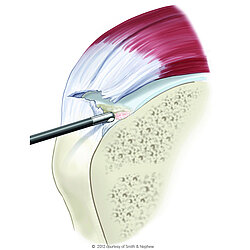The shoulder: a unique construction
The shoulder joint is a "muscle-lead" joint, i.e. the joint's connection is mainly effected by muscles, being only little supported by bony structures. As related to the daily demands, the shoulder joint disposes of a merely weak capsule-ligament apparatus. This allows for extreme mobility in any direction of the axes in space, thereby making this very joint unique. But this construction's particular setup is also rather predisposed to injuries, as other joints - like for example the hip - get additional stabilisation from their bony design, their capsules and ligaments.
Mobile, but sensitive
Doing some sports is (generally) good for your health, but it may as well affect your bones and joints. One of the joints most at risk is the shoulder joint. Injuries by fall, for example when riding bicycle, skating, skiing, playing handball or ice hockey, are the typical "shoulder killers". These cover the entire range from rather harmless irritations at the muscular insertions over painful dislocations with muscle, capsule, ligament and tendon raptures up to avulsion fractures.
Besides direct impact of force, e.g. when falling on the stretched arm, shoulder problems are often derived from chronic overexertion. First appearances of attrition are to be observed as of the age of about 35. If the shoulder is then exposed to spontaneous and massive overexertion - as for example by a fall when skiing - the muscles are very likely to finally wear out, the upper arm may dislocate, the rotator cuff may tear or even parts of the bony tissue may crack off.










